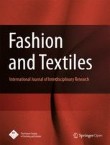Fashion and Textiles is affiliated with The Korean Society of Clothing and Textiles
Measurement of antibacterial properties of foil-backed electrospun nanofibers
Current methodologies for evaluation of antibacterial properties of traditional textiles are not applicable to foil-backed, poorly-absorbent electrospun nanofiber materials, since existing test methods require...
